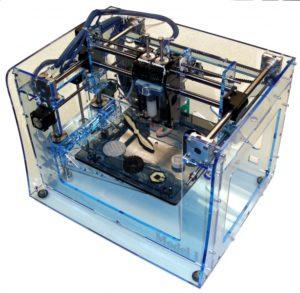Whereas most of the media focus around 3D printing was initially directed at desktop 3D printing, a lot of the opportunity is actually in industry. Industrial 3D printing can unlock value for manufacturers by making their supply chains more flexible. Part count reduction and weight reduction in parts can lower costs. By using 3D printing to manufacture, time to market is reduced and on-demand production becomes possible. For many companies, especially in aerospace and other high-end applications, manufacturing using 3D printing is an exciting prospect. Additive manufacturing itself will need to mature and become more production ready however. Partially this is an ongoing process and in this article we’ll look at what needs to be done in getting 3D printing to the point where it is a manufacturing technology.
- Software Toolchains Must be Improved and Optimized.
- 3D printing is seen by many as a hardware challenge. 3D printing is however a hardware, software and materials challenge. Software is key to improving the quality of 3D printed output and optimizing the process. Software such as Cura or Simplify3D is great for use at home or at the office but if we want to move to production a number of additional things have to happen. One of the main ones is for Cura and Simplify to become easier to use still while automatically having optimal settings for each material and part.
- One click 3D printing. 3D printing is still too difficult. Slicing software is too complex. A casual user should with a “right click print” press of a button be able to get a printer to print a file correctly. Infill settings, fan speed and all of these types of things should not be required as an input. If we want to go beyond the aficionados and towards millions of users one click 3D printing needs to become a reality.
- Build optimization. With Magics and other software one can already optimize builds. But, the completely optimized automated build chamber software of our dreams does not exist yet. Complete with cost and throughput analysis and using powerful algorithms to fill builds in keeping with the best part orientation and quality this would have to be created per 3D printing technology.
- Financial Optimization of Builds. Formulas such as profit velocity have let me optimize and calculate costs and yields of 3D printing products while optimizing for product type, profitability, size and nesting in a build. This is a torturous process and has to be done by hand. This sucks and everyone would make more money if they could simply analyze automatically which product would make sense financially. Logically however the printer is a machine where automatically I would always like to know how much money it could make per minute.

AI Build uses AI and machine learning to improve its large scale 3D prints.
- AI anyone? Artificial intelligence and big data are amazing buzz words but how about we use these things to analyze, predict and improve the builds of our 3D printers? Companies such as AI Build and 3DSIM are among a handful of companies that are bringing much needed AI and simulation to 3D printing.
- We Need Better Materials.
- 3D printing materials suck and new dedicated 3D printing materials need to be developed. Now that Arkema, BASF, DuPont, SABIC, Mitsubishi Chemical and Eastman are active in our market we can surely have higher-performance 3D printing materials, right? I mean they’ll use their expertise to develop better materials not only push us towards a particular resin they happen to make a lot of?
- Most FDM filaments are horrible in quality. What kind of muppets are we that we routinely pay $40 for a kilo of filament with bubbling, that’s old and that does not have a good roundness or tolerance on the diameter? A lot of materials have incomplete MSDS that do not disclose what is in the material. I’ve found materials that even have different polymers in them. This is ridiculous and should be improved.
- Certification of 3D printing materials is ongoing but in many areas it is still lacking. Newer food safe, on the body safe, skin safe, FR, for use in aviation etc. These newer certified materials would open up many new application areas for 3D printing.
- Materials testing needs to be standardized. It makes me sad to read yet another paper closely and to conclude that the research is garbage. Often material handling, nozzle temperature, slicer, version of slicer, placement on the build platform, actual nozzle temperature and many other factors are not controlled for properly. This means that rather than building up a corpus of 3D printing research we can all build upon most of it is crap.
- We Need Better 3D Printers.
- Build speed is too low for all technologies. In what other industry would you buy a $150,000 machine that spends 60% of its time preparing itself to work? Significant build speed increases would improve the economics of 3D printing.
- Could we develop things faster please? For a lot of people it may seem that 3D printing is coming along quite quickly. Below is an image of a Fab@Home 3D printer from 2006, and one of the Motorola RAZR, one of the coolest phones from the same time. We need to develop 3D printing technology much quicker if we’re going to move from the hobby scale to production scale 3D printing. The RAZR is a relic and is significantly surpassed in functionality by cell phones on offer today. Meanwhile the Fab@Home resembles in many ways a lot of the printers on offer today.
- A Fab@Home 3D printer made open source in 2006.
- We need less post processing. Post processing equipment and lines have to be made in order to drastically reduce the handling cost of 3D printed parts. A guy with a brush brushing away powder is not going to let us revolutionize manufacturing. There are more and more companies emerging that will ameliorate this but not enough is happening.
- Build volumes are still too small. We set off with a RepRap and now everyone is making a RepRap super duper plus without having done any research to how large a 3D printer has to be. Meanwhile other people are building houses because that is what will get them on CNN. Could people please analyze what types of parts need to be a particular size and what their performance needs to be before building a 3D printer? Yes, my 3D printer is desktop but my dishwasher is not.
- Please, I’m begging you: Could someone please solve the bed adhesion problem for FDM printers? I feel like a total tool when I have to wait around for a $3,000 piece of hardware to correctly and coherently stick a layer of plastic to a build platform.
- Reliability and repeatability of systems has to increase. Over 90% uptime seems delicious until you realize that this is crap when compared to almost any other piece of production machinery. I wouldn’t be happy if my laptop worked 90% of the time or if nine out of the ten things in my oven were heated up. I’d take the elevator a lot less if one of ten trips resulted in me getting stuck. People, we’re going to be living in a world where people want to 3D print aircraft. Amateur hour is over.
- Could FDM printers be made just a little more silent please? The siren song of 3D printers is lovely. I’m at a point right now where sometimes I feel a little bit restless in my house without being able to put a finger on it. I then realize that I’m not printing anything and the absence of the sound is making me uneasy. But, would it really be that hard to make an almost noiseless 3D printer? We live in an age where a high school class with a bit of gumption could put a small satellite in orbit around the planet. Silent 3D printers will let people use them in classrooms and offices without disturbing people.
Subscribe to Our Email Newsletter
Stay up-to-date on all the latest news from the 3D printing industry and receive information and offers from third party vendors.
You May Also Like
Precision at the Microscale: UK Researchers Advance Medical Devices with BMF’s 3D Printing Tech
University of Nottingham researchers are using Boston Micro Fabrication‘s (BMF) 3D printing technology to develop medical devices that improve compatibility with human tissue. Funded by a UK grant, this project...
3D Printing Webinar and Event Roundup: April 21, 2024
It’s another busy week of webinars and events, starting with Hannover Messe in Germany and continuing with Metalcasting Congress, Chinaplas, TechBlick’s Innovation Festival, and more. Stratasys continues its advanced training...
3D Printing Webinar and Event Roundup: March 17, 2024
It’s another busy week of webinars and events, including SALMED 2024 and AM Forum in Berlin. Stratasys continues its in-person training and is offering two webinars, ASTM is holding a...
3D Printed Micro Antenna is 15% Smaller and 6X Lighter
Horizon Microtechnologies has achieved success in creating a high-frequency D-Band horn antenna through micro 3D printing. However, this achievement did not rely solely on 3D printing; it involved a combination...































